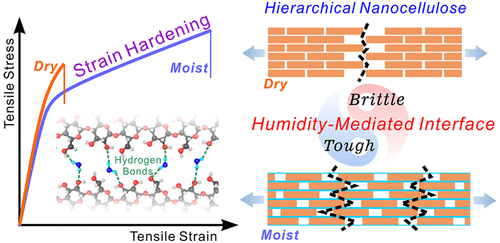Our official English website, www.x-mol.net, welcomes your
feedback! (Note: you will need to create a separate account there.)
Strengthening and Toughening Hierarchical Nanocellulose via Humidity-Mediated Interface
ACS Nano ( IF 15.8 ) Pub Date : 2020-12-29 , DOI: 10.1021/acsnano.0c08574 YuanZhen Hou 1 , Qing-Fang Guan 2 , Jun Xia 1 , Zhang-Chi Ling 2 , ZeZhou He 1 , Zi-Meng Han 2 , Huai-Bin Yang 2 , Ping Gu 1 , YinBo Zhu 1 , Shu-Hong Yu 2 , HengAn Wu 1
ACS Nano ( IF 15.8 ) Pub Date : 2020-12-29 , DOI: 10.1021/acsnano.0c08574 YuanZhen Hou 1 , Qing-Fang Guan 2 , Jun Xia 1 , Zhang-Chi Ling 2 , ZeZhou He 1 , Zi-Meng Han 2 , Huai-Bin Yang 2 , Ping Gu 1 , YinBo Zhu 1 , Shu-Hong Yu 2 , HengAn Wu 1
Affiliation

|
Undoubtedly humidity is a non-negligible and sensitive problem for cellulose, which is usually regarded as one disadvantage to cellulose-based materials because of the uncontrolled deformation and mechanical decline. But the lack of an in-depth understanding of the interfacial behavior of nanocellulose in particular makes it challenging to maintain anticipated performance for cellulose-based materials under varied relative humidity (RH). Starting from multiscale mechanics, we herein carry out first-principles calculations and large-scale molecular dynamics simulations to demonstrate the humidity-mediated interface in hierarchical cellulose nanocrystals (CNCs) and associated deformation modes. More intriguingly, the simulations and subsequent experiments reveal that water molecules (moisture) as the interfacial media can strengthen and toughen nanocellulose simultaneously within a suitable range of RH. From the perspective of interfacial design in materials, the anomalous mechanical behavior of nanocellulose with humidity-mediated interfaces indicates that flexible hydrogen bonds (HBs) play a pivotal role in the interfacial sliding. The difference between CNC–CNC HBs and CNC–water–CNC HBs triggers the humidity-mediated interfacial slipping in nanocellulose, resulting in the arising of a pronounced strain hardening stage and the suppression of strain localization during uniaxial tension. This inelastic deformation of nanocellulose with humidity-mediated interfaces is similar to the Velcro-like behavior of a wet wood cell wall. Our investigations give evidence that the humidity-mediated interface can promote the mechanical enhancement of nanocellulose, which would provide a promising strategy for the bottom-up design of cellulose-based materials with tailored mechanical properties.
中文翻译:

通过湿度介导的界面增强和强化分层纳米纤维素
毫无疑问,湿度是纤维素不可忽略的敏感问题,由于无法控制的变形和机械性能下降,通常被认为是纤维素基材料的一个缺点。但是,由于缺乏对纳米纤维素的界面行为的深入了解,特别是在变化的相对湿度(RH)下,难以维持纤维素基材料的预期性能。从多尺度力学出发,我们在此进行第一性原理计算和大规模分子动力学模拟,以证明在分层纤维素纳米晶体(CNC)和相关变形模式中湿度介导的界面。更有趣的是 模拟和后续实验表明,水分子(水分)作为界面介质可以在合适的相对湿度范围内同时增强和增韧纳米纤维素。从材料界面设计的角度来看,具有湿度介导界面的纳米纤维素的异常力学行为表明,柔性氢键(HBs)在界面滑动中起着关键作用。CNC-CNC HBs和CNC-CNC-水-CNC HBs之间的差异触发了纳米纤维中湿度介导的界面滑移,导致出现明显的应变硬化阶段,并抑制了单轴拉伸过程中的应变局部化。具有湿度介导的界面的纳米纤维素的这种非弹性变形类似于湿木细胞壁的维可牢尼龙搭扣状行为。
更新日期:2021-01-26
中文翻译:

通过湿度介导的界面增强和强化分层纳米纤维素
毫无疑问,湿度是纤维素不可忽略的敏感问题,由于无法控制的变形和机械性能下降,通常被认为是纤维素基材料的一个缺点。但是,由于缺乏对纳米纤维素的界面行为的深入了解,特别是在变化的相对湿度(RH)下,难以维持纤维素基材料的预期性能。从多尺度力学出发,我们在此进行第一性原理计算和大规模分子动力学模拟,以证明在分层纤维素纳米晶体(CNC)和相关变形模式中湿度介导的界面。更有趣的是 模拟和后续实验表明,水分子(水分)作为界面介质可以在合适的相对湿度范围内同时增强和增韧纳米纤维素。从材料界面设计的角度来看,具有湿度介导界面的纳米纤维素的异常力学行为表明,柔性氢键(HBs)在界面滑动中起着关键作用。CNC-CNC HBs和CNC-CNC-水-CNC HBs之间的差异触发了纳米纤维中湿度介导的界面滑移,导致出现明显的应变硬化阶段,并抑制了单轴拉伸过程中的应变局部化。具有湿度介导的界面的纳米纤维素的这种非弹性变形类似于湿木细胞壁的维可牢尼龙搭扣状行为。

































 京公网安备 11010802027423号
京公网安备 11010802027423号